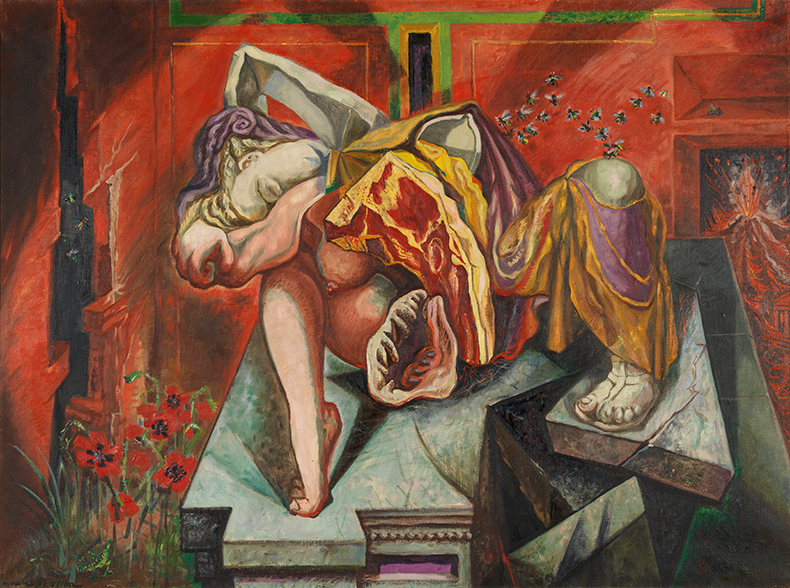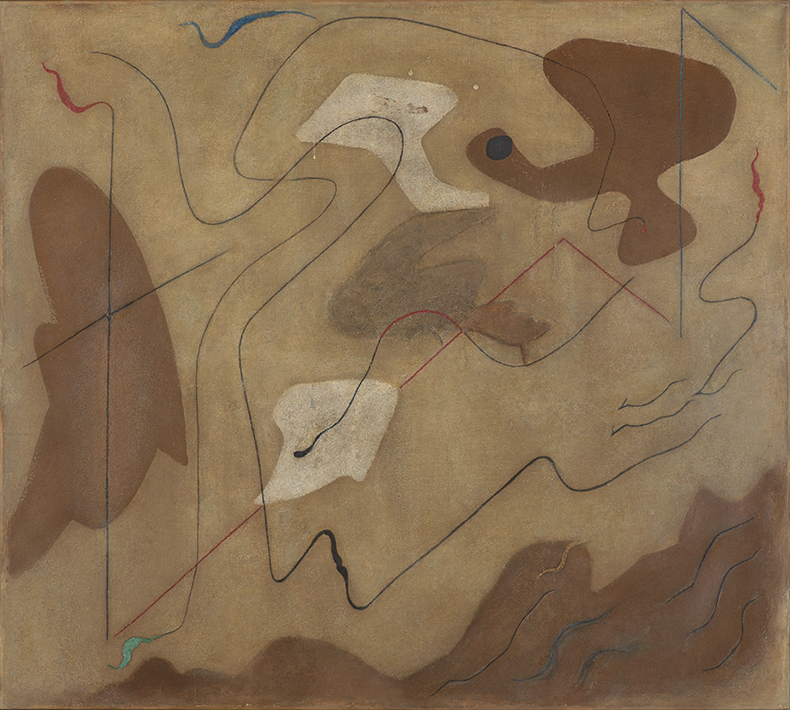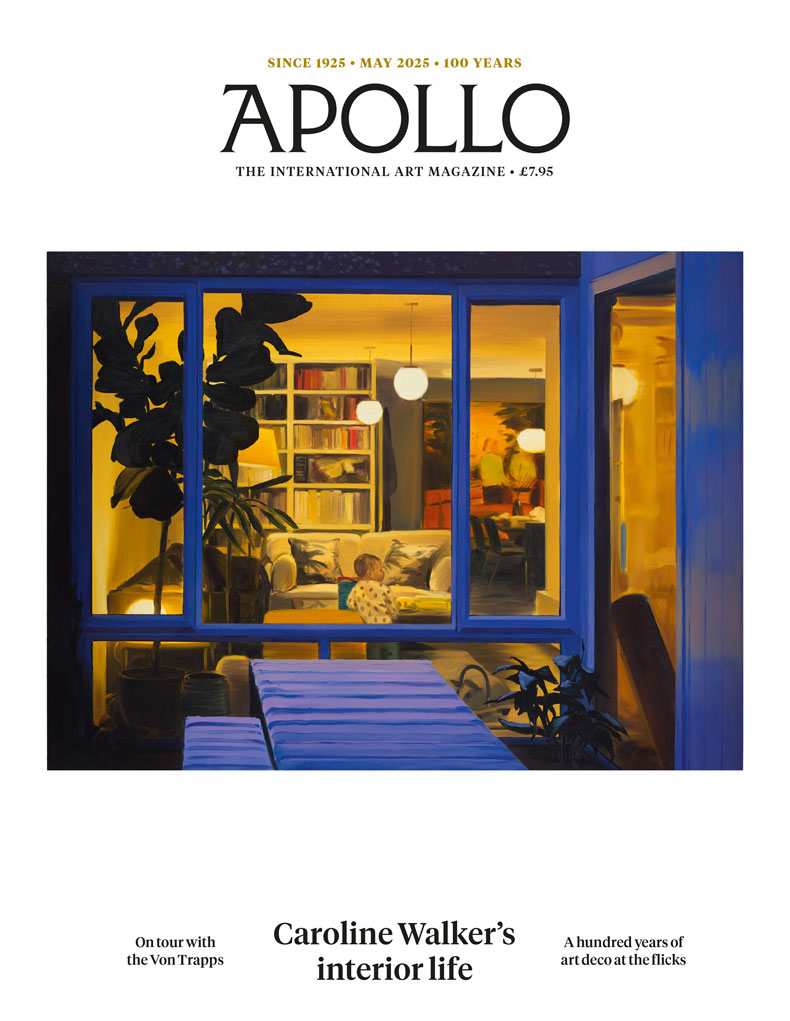From the June 2024 issue of Apollo. Preview and subscribe here.
Perhaps the best place to start your visit to the new monograph show of André Masson’s work at the Centre Pompidou-Metz would have been the exhibition a couple of floors below it, which closed at the end of May. ‘Lacan: the Exhibition’ (reviewed in last month’s Apollo) included Gustave Courbet’s infamously unblinking portrait of a vulva, L’Origine du monde (1866), on loan from the Musée d’Orsay. Next to it was a distant, if smaller, response to Courbet’s painting. Terre érotique (1955) consists of a white line on a brown background, sketchily suggesting those things that L’Origine du monde makes eminently clear.
The story that connects these two paintings is, as you might imagine, colourful. In 1955, flush with psychoanalytic cash, Jacques Lacan had bought L’Origine du monde for 1.5 million francs. His wife, Sylvia, presumably sensing that some visitors to chez Lacan might find the image challenging, commissioned her brother-in-law to paint a modesty screen to fit over Courbet’s work. The artist, married to her sister Rose, was André Masson – and Terre érotique was the not-exactly-modest result.

Le jardin saccagé (1934), André Masson. Private collection. Photo: © Jean-Louis Losi; © Adagp, Paris, 2024
When it came to depicting pudenda, Masson had form. In May 1941, fleeing France from the invading Germans (Rose was Jewish), the family had arrived in New York. A US customs official, going through their luggage, had found a precursor of Terre érotique: a drawing of a tiny woman standing in a landscape that also read as a vagina. The work was pronounced pornographic and confiscated. Masson, outraged, spluttered: ‘Vous n’avez aucune mythologie!’
It may be useful to know all this as you visit the Masson exhibition itself. If the confiscated New York drawing is absent, for obvious reasons, another picture is on show – a drypoint etching called Rapt. Made within weeks of Masson’s arrival in America, it is an extraordinary piece, its wild line recalling its maker’s role as one of the pioneers, in 1924, of automatic drawing. Around the corner from it is Pasiphaë, a painting made in Connecticut the following year and claimed, by Masson at least, to have been an influence on a young Jackson Pollock. Whether or not this was true (and it probably wasn’t), a copy of Rapt hung on the wall of Atelier 17, the exiled Parisian printmaking shop where Pollock made his noticeably Masson-like prints. From Rapt’s flung line to Pollock’s flung paint seems less of a stretch than from Pasiphaë to, say, Full Fathom Five.

Le Labyrinthe (1938), André Masson. Centre Pompidou, Musée national d’art moderne, Paris. © Philippe Migeat/Centre Pompidou, MNAM-CCI/Dist. RMN-GP
All of which raises a question. Why, since the Zelig-like Masson was everywhere – in at the birth of Surrealism and Abstract Expressionism; at the heart of French psychoanalysis – is this the first major monograph show of his work in a public gallery since 1976? (The latter was at the Museum of Modern Art in New York, moving to the newly opened Centre Pompidou the year after.) And why in Metz rather than Paris?
A visit to ‘André Masson: There is No Finished World’ suggests various reasons. Although the Pompidou-Metz’s exhibition is beautifully hung and intelligently curated, it is also intentionally puzzling. Arranged so that the visitor is left to find his or her own way around the show – the open-ended sub-galleries are described as being like the mandibles of a praying mantis – there is no obviously neat way through it. This is because Masson’s progress as an artist was itself untidy.
An early signatory to André Breton’s Surrealist manifesto, he broke with the movement not once but twice. In both Surrealist phases, his work was by turns burningly cerebral and slightly mad. A reconstruction in the show of Masson’s library of more than 2,000 books suggests the ferocity of his intellect: Promethean is hardly too strong a word. As a classicist and follower of Freud and Jung, he merged Greek mythology with his own. Thus Pasiphaë is both the story of the mother of the Minotaur and an exploration of the artist’s own sexual anguish, a visceral confection of biomorphic forms and what look like escalators, rendered in sand and paint.

Gravida (1938–39), André Masson. Photo: © Georges Meguerditchian – Centre Pompidou, MNAM-CCI/Dist. RMN-GP; © Adagp, Paris, 2023
There are so many Massons in Metz that it is impossible to make easy sense of them. In one gallery, there are paintings of insects dating from the mid 1930s – mantises as bullfighters, fighting taurean locusts (Les insectes matadors, 1936); merry-looking mantises enjoying winter sports (Divertissement d’été, 1934); insects of various kinds trashing a garden (Le Jardin saccagé, 1934). In another, there are highly wrought mythological paintings from Masson’s second Surrealist period – works such as Le Labyrinthe (1938), labelled with its maker’s own explanation of the work’s genesis after his disconsolate return from Franco’s Spain. And there are many, many more potential pathways through the show, stylistic and material. The Pompidou-Metz exhibition is above all a map of Masson’s mind, its doublings-back and veerings-off a portrait of the artist’s imaginative life.
But then this embarras de richesses is the real reason for going to the exhibition. Rather than trying to neaten Masson into an easy (or even likeable) artist, it celebrates his complexity. This is not a lazy show: it helps to have done some homework before you go. That may explain why Masson exhibitions are so exceedingly rare. The good news is that, in the Borgesian souk of his mind, there is something for everyone. Personally, I find high Surrealist works such as Dans la tour du sommeil (1938) overblown and hard to look at. The more abstract Masson becomes, the more loveable. Early sand paintings such as Les cerfs-volants (1927) have the kind of Miroesque purity that pulls you up short. On their account alone, I really do recommend you see this show. Who knows when there will be a chance again?

Les cerfs-volants (1927), André Masson. Photo: © Galerie Jacques Bailly/Adagp, Paris, 2023
‘André Masson: There is No Finished World’ is at the Centre Pompidou-Metz until 2 September.
From the June 2024 issue of Apollo. Preview and subscribe here.














![Masterpiece [Re]discovery 2022. Photo: Ben Fisher Photography, courtesy of Masterpiece London](http://zephr.apollo-magazine.com/wp-content/uploads/2022/07/MPL2022_4263.jpg)
Suzanne Valadon’s shifting gaze